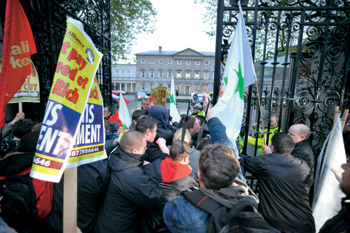Banks and government – joined at the hip

With Ireland's banking and fiscal crises now inextricably linked, any proposed solution to one that doesn’t address the other is doomed to fail writes Dan White
11 October 2010
 Ever since the Irish banking crisis first erupted into public view just over two years ago Finance Minister Brian Lenihan has done a good job of persuading the international bond markets that the ever-growing financial black hole that our banking system has become was somehow separate from our rapidly-deteriorating public finances.
Ever since the Irish banking crisis first erupted into public view just over two years ago Finance Minister Brian Lenihan has done a good job of persuading the international bond markets that the ever-growing financial black hole that our banking system has become was somehow separate from our rapidly-deteriorating public finances.
Like the good barrister that he is, Lenihan has brilliantly argued a bad case. And for two years most bond investors were prepared to accept his line that the government had the situation under control and that, to use his words from his December 2009 budget speech, we had “turned the corner”.
Looked like they could pull it off
In the first few months of 2010 it briefly appeared that Lenihan and his boss, Taoiseach Brian Cowen, might just pull it off. The international economic outlook briefly improved, Irish exports rose and there were indications that, measured by GDP at least, the Irish economy had bottomed out. Things might not be getting any better but we could at least dream to hope that they had stopped getting worse.
Then the Greek financial crisis went nuclear in May and the ECB and the IMF were forced to establish a €750bn emergency fund to save the euro from destruction. The climax of the Greek crisis inevitably focused attention on the other peripheral eurozone economies including Ireland.
The interest rate demanded by investors on Irish government bonds crept up throughout the summer. Then on 24 August ratings agency Standard & Poor’s cut Ireland’s credit rating. While the downgrade was not unexpected, by explicitly linking its decision to the escalating cost of the bailing out the banks and its impact on the national debt, S&P crystallised mounting investor doubts about the credibility of Ireland’s fiscal strategy.
Ireland’s credit rating dives
Matters weren’t helped when just a week after S&P cut Ireland’s credit rating, Anglo Irish, which has become the poster boy for the banking excesses of the Celtic Tiger years, revealed that the likely cost of bailing it out had risen once again, from €22.9bn to €25bn. For what it is worth even this figure is likely to be comfortably exceeded with most independent analysts putting the likely final cost of the Anglo debacle at somewhere between €35bn and €40bn.
Not to put too fine a point on it, with the cost of bailing out the banks now up to at €90bn, investors have been forced to look again at the government’s plans to reduce the budget deficit to 3% of GDP by 2014. When they have done so they have quickly discovered that there is far less to the government’s plans than meets the eye.
In order for the government to meet its budgetary targets tax revenues will have to rise by 27% from €31bn in 2010 to €39.5bn in 2014 while nominal GDP would have to increase by 28% to €207bn over the same period. Even allowing for forecast cumulative inflation of 7% in the four years to the end of 2014, this still means that the government is expecting a one-fifth increase in real tax revenues and a 21% increase in real GDP.
Anyone who seriously argues that the Irish economy will grow by more than a fifth in real terms over the next four years is either lying through their teeth or dangerously deluded, perhaps both.
Bail out costs still rising
Meanwhile the cost of bailing out the banks continues to grow like topsy. S&P has already put the total cost at €90bn. The rating agency’s methodology in arriving at this figure was strongly attacked by several government ministers when it cut Ireland’s credit rating in August. They argued that, by placing no value on either the bad loans being transferred to NAMA or the state’s shareholdings in the Irish-owned banks, S&P was exaggerating the likely final cost.
I don’t think so. If the state does eventually recover some money from the loans being purchased by NAMA or from selling shares in the banks back to the private sector well and good. Unfortunately such an eventuality, if it ever happens, is years in the future. As things stand the value of the loans being purchased by NAMA and the state’s bank shareholdings is as close to zero as makes no difference. Unless and until that changes, the only prudent course is to value these assets at zero.
And this cost makes no allowance for a likely explosion in mortgage write-downs. The Irish-owned banks have residential mortgages with a book value of ?99bn on their balance sheets. So far only a tiny portion of these have been written off.
Mortgage arrears soaring
Consider the facts: House prices have already fallen by 50% and will probably fall by a further 50% from their current levels, i.e. a cumulative fall of 75%, before bottoming out. Mortgage arrears are soaring. While the official figures released by the Financial Regulator put the level of mortgage arrears at just 4.6%, no-one outside officialdom believes these.
In a report published last month S&P revealed that arrears on pools of mortgages sold to investors by sub-prime mortgage lender Start are running at between 13% and 45%.
Even a 10% write-down in the value of the Irish-owned banks’ residential mortgages would result in fresh losses of almost €10bn. A more realistic 30%-40% write-down would result in losses of €30bn-€40bn. Losses of this magnitude would almost certainly sweep away most of if not all of the Irish-owned banks.
Banks and Government inextricably linked
The banks and the government are now inextricably joined at the hip. It is the mounting cost of bailing out the banks that has so undermined the confidence of the international bond markets in the Irish government while the banks only continue to survive because the government has guaranteed their deposits. An Irish sovereign debt crisis would almost certainly trigger a run on the banks while a run on the banks would be the signal for an Irish sovereign debt crisis. Mutually assured destruction.
It is this combination of utterly unrealistic budget forecasts and the ever-rising cost of bailing out the banks which pushed yields on ten-year Irish government bonds up to over 6.5% late last month. The Irish exchequer can’t afford to pay such high interest rates for any length of time. The National Treasury Management Agency (NTMA) has got to get the yields on new issues of Irish government debt down to more affordable levels and quickly.
To do so the government will have to come up with a realistic strategy for dealing with the twin fiscal and banking crises. Unless it does so quickly both the sovereign Irish state and the Irish-owned banks will quickly go bust.



 Print
Print






Fans 0
Followers